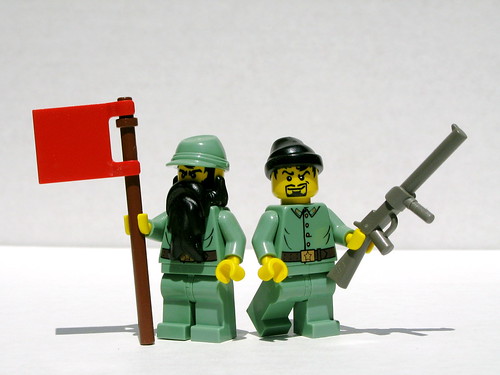
APOLOGY:
I'm sorry if anyone came to see me in my office from 12:00-1:15... I forgot about my weekly HumCore staff meeting... hopefully you saw the note on the door
SURVEY:
Most of you didn't take it yet...
here's the link. Please try to come up with suggestions for my/our improvement. One person took the survey and basically chose "suck" for everything in the numerical part,
which is totally fine, but then wrote something to the effect of "everything seems OK, no suggestions" in the written comment part. I found that rather confusing. If you have a grievance, elaborate. If you like something, tell me how to do more of it. Etc.
HOMEWORK:
-ask Goebbels a question about Nazi aesthetics in reply to this post... no more communist nonsense, today the teacher/fuhrer answers all the questions...
you are free to choose from Moeller's own study questions if this is really what you want to know-
Reader 92-101 (Soviet Aesthetics)
-read Moeller's handout on
primary vs. secondary sources (a simple demonstration is pg. 97 vs. pg. 100-01)
-read
Guide ch. 15 & 16 if you haven't already
TIMETABLE FOR PAPER #5:
Thursday 2/12 @ 9pm = ideas draft (to submission dropbox... see below)
Tuesday 2/17 @ 5pm = working draft (to shared dropbox)
Wednesday 2/18 @ various = group conferences
Sunday 2/22 @ 9pm = final draft (to turnitin.com)
THIS MIGHT BE MORE HELPFUL THAN THE ACTUAL PROMPT:
Grading rubric the instructors were given (or
in .pdf format if you prefer)
ACCEPTABLE ALTERNATIVES TO ARTSTOR, CALVIN, AND U.S.H.M.M. :
-
Rifkind German Expressionist collection... some of this is online, but you could go to the
Los Angeles County Museum of Art, like I did this past weekend, and see all this stuff and more... sometimes it's easier to analyze a painting/poster/photograph if you're actually looking at it than a web image
-University of Minnesota
World War poster collection (careful with dates)
-German Federal
ArchivesIDEAS DRAFT #5 (NOT AS LONG AS THE LAST ONE, BUT LONG):
You need to find six images. Five should come from approved databases [Artstor, Calvin, U.S.H.M.M., Rifkind, U. Minnesota]. Use at least two of the databases... you can repeat images from your Discovery Task, but be sure that they fit the theme you choose, and be sure that you have something interesting to say about them. The sixth image should be a contemporary one (
from any source) that somehow fits your theme, even though it's not directly about Weimar.
Winter's 2 S'sSource: who publishes/curates the database this image came from? what is its focus? what are its motives? [do this once for each database you use]
Selection: what category or theme have you chosen to organize your exhibition/article [do this once]...
note: one potential category we didn't discuss in class today was the work of a single artist... though it would be better if there was some variety thereinMoeller's 6 C's [repeat six times, one for each image]
Content: what do you see? (in detail... more work now is less work later)
Citation: who made it? how did s(he) display or publish it?
Context: what was going on at this particular place and time? (be specific... not every year in the Weimar period is quite the same, and not every city in Germany is quite the same)
Connections: does this remind you of anything else you've studied in Core this year? (hint: yes)? does it remind you of any other images/ideas (hint: yes)? copy out at least one short quotation from a pertinent primary or secondary source (like from the
Reader)
Communication: what's the message, or rhetorical appeal, or propaganda angle? if there's none on the part of the artist/photographer, how might someone else interpret it as such? (example: Grosz calling
Primavera bourgeois propaganda)
Conclusions: why is this image historically interesting/valuable? how does it relate to your theme? use it or lose it? (since you will be cutting down from six to three)









